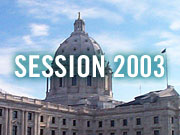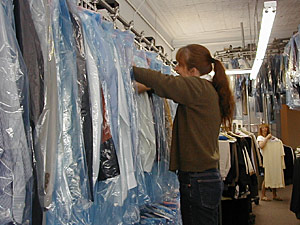Audio
Photos
More from MPR
Your Voice
| |||||||||||||||||||||||||||||||||||||||||||||||||||||||||||||||
Officials fear child care-to-welfare shift
June 9, 2003
Starting in July, child care will become more expensive for thousands of Minnesota families. To help balance the state budget, lawmakers approved cuts in state child care subsidies. Overall the changes are projected to save the state more than $86 million over the next two years. But the cuts may have a secondary effect: Driving some lower-income, working families onto the welfare rolls.
Minneapolis, Minn. — Laurie Possin is just beginning to distribute the bad news. Possin is associate director of the Greater Minneapolis Day Care Association, a non-profit that administers "sliding fee" child care subsidies. In Hennepin County -- the state's biggest -- 3,700 working families use the program. Over the next six months, 142 of them will lose child care help altogether. Hundreds more will become ineligible and drop from the waiting list. Remaining families will see varying jumps in their co-payments, the amount they pay before the state kicks in the rest. Typical co-pay increases are between 40% and 60%.
Possin says for many parents, hearing from her will be a life-altering event. "I think there's two choices," she says. "One is whether they can remain working. And one is whether they can remain in a quality child care program."
 | |||
Consider a single mother of two making $27,000 a year. Under current guidelines, she could enroll in the program and pay just $96 a month for child care. After July 1, she makes too much to enroll. In the metro area her out-of-pocket child care costs would likely be at least $1,000 a month, or 44 percent of her income.
Even the same woman making $38,000 a year will see her child care bill double and consume almost a third of her paycheck. A parent in this income level would not only be ineligible to enroll in the program, but would lose her current coverage if she were already enrolled.
Possin says parents in this range could find it a better economic choice, or even a necessity, to quit a better-paying job and enroll in the state's welfare-to-work program.
"If this family has an infant and a toddler, and sees no way out and simply has no other person to care for their children, it literally leaves people no choice," Possin says. "So it could happen, and it has happened in the past."
Possin and Hennepin County officials see proof in the county's year-long waiting list. Consistently about a quarter of families on the list, at all income levels, leave it to enroll in the welfare-to-work "Minnesota Family Investment Program," where child care help is guaranteed. The evidence is anecdotal, but Possin believes it is the cost of affording child care on their own that drives them there.
 | |||
State officials say they have no way of estimating how many parents might make this choice. Counties report the information on individual families that receive child care subsidies, but only report aggregate information on welfare recipients.
In any case, says a Department of Human Services forecaster, up until this session child care benefits have only increased, so there is no precedent for knowing how families will react when benefits are cut. The possibility of former subsidy recipients turning to welfare was not accounted for in the health and human services budget passed by the Legislature.
The calculations would be complicated; each family receiving child care help receives a different subsidy based upon their income and child care provider. But welfare is arguably the more expensive proposition for the state.
While the federal government picks up 43% of the cost of subsidized child care, it picks up only 37% of providing for a family on welfare (about half of a monthly welfare check comes from a federal block grant the state could spend for various other purposes).
Human Services Commissioner Kevin Goodno finds the child care-to-welfare scenario a little hard to believe.
"There may be the occasional person, but for the most part I don't see that as something that's going to happen," Goodno says. "To make this automatic assumption that because we cut those levels, that people would jump onto welfare because of that, is making a judgment that isn't consistent with the work ethic of Minnesotans."
Goodno says child care did take a larger hit than even Governor Pawlenty originally suggested, but he points out the child care changes prevented deeper cuts in nursing home coverage and medical care for the poor and disabled.
And he says lawmakers did preserve very affordable child care co-pays for those with the lowest incomes. The change could also shrink notoriously long waiting lists. Goodno says it was unfair that there were families making $35,000 receiving subsidies while families making $15,000 had to wait as long as a year for a spot.
 | |||
"Our intent, in refocusing the program on lower income levels, was to really help those people most in need, and those that really don't have the resources," Goodno says.
Business people like Dan Parker might have reason to worry about those caught between daycare and their job. Parker employs 40 people in his aWhite Way chain of Twin Cities cleaners. Many of them have been on welfare, and many have children. Child care is one of a number of factors that may make it a seem like a smarter choice to leave.
"They're making an economic decision," Parker says. "Will they have more money at the end of the day if they're on welfare, plus medical plus child care ... than they will if they're working for $10, $11, $12 an hour and they have to pay half of that in child care and medical support?"
Parker worries about the cost of replacing even one or two employees forced to choose their children over their job.
The effect of the cuts will play out well into the fall. Commissioner Goodno says there are still tax breaks and other federal programs for those who lose state help with child care. And one Hennepin County official says even though they are expecting a bump in the welfare rolls, many families will find their own ways to get by.
|
News Headlines
|
Related Subjects
|


